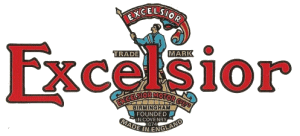


1933 Excelsior C14 IOM Special

Excelsior 1935 Manxman 250cc Cockpit
1896 The firm started to produce powered machines and, during an exhibition at the Crystal Palace, demonstrated a motorcycle fitted with 1.25hp Minerva engine. Approximately 250 people tried it out without mishap.
1900 The firm started using the MMC engine, with belt drive, hung from the downtube.
1904 Several motorcycle models were now in production and some had water cooling.
c1905 Trade was poor, so motorcycle production ceased.
1909 They returned to the market with one motorcycle model. This had a 3.5hp Excelsior engine, gear-driven Bosch magneto, Druid forks and twin fuel tanks.
When they entered the car business they used the name Bayliss-Thomas as there was already a Belgian car called the Excelsior. The prototypes had three wheels and air-cooled engines, but production vehicles were conventional 9-13 hp four wheelers and around 1000 were made.
1912 Spennell's lists them at Excelsior Works, Stoney Stanton Rd (Tel. 497) and manufacturers of motorcycles.
1920 A much wider range of models was introduced. That year they were incorporated as a private company.
1921 The firm moved to Kings Road, Tyseley, Birmingham, and started to trade as the Excelsior Motor Co. The Walker family (father Reginald and son Eric) took over and after a couple of years, they dropped the original name of Bayliss, Thomas and Co.
1923 More models were added to the range, using engines by Blackburne, Villiers and Bradshaw. These were used on a wide variety of bikes from sidecar to TT models.
1924 The company produced a 600cc side-valve single. Two more models were added with a 545cc Blackburne engine, one for sidecar work and the other a TT model.
A report from the 1924 Motor Cycle Show reads:
Wright's One-way Speed.
JUST over 163 m.p h. was achieved by the English rider, J. S. Wright, and his Silver Comet Excelsior-J.A.P. machine at Tat, Hungary, recently. Several of his attempts on his own world's maximum speed record have been dogged with ill-luck, but newspaper advices from England disclose that, determined to break the record, he was staying on until he succeeded.
First of all, trouble with the rear piston set in, and then the supercharger went on strike, and Wright could not cover the course in both directions, as is required. A new blower was sent to him, but, as the cables have been silent concerning him, the attempts probably failed.
Trove NLA Brisbane Courier Dec 3, 1931
1932 More variations with Villiers or JAP engines appeared.
1933 The company had always supported the TT and, for that year's 'Lightweight', produced a winning motorcycle with a special Blackburne engine known as the Mechanical Marvel - so called because of four radial valves opened by twin high-camshafts using push-rods and rockers, twin carburettors and dry-sump lubrication.
1935 The four-valve 250cc Manxman was released, later produced in 350cc and 500cc sizes, as well as a 250cc model with a fully-enclosed, water-cooled engine.
1937 They made a 98cc Autobyke, the forerunner of modern mopeds, and built a 98cc Sprite for Corgi.
Wartime (1939-1945) The firm built the SOE's Welbike, which eventually became the post-war Corgi.
In the lean years following the Second World War, racing and luxury machines were sidelined in favour of relatively inexpensive two-strokes, the flagship being the Talisman twin, powered by a 243cc four-speed Villiers engine. Their best seller in this period was the Consort, achieving a peak production of 10,000 units annually.
1949 They produced the Talisman, a smooth two-stroke with 180-degree crank. A later, 328cc twin-carb sports version did not sell well.
1950 The Talisman Twin added, with a 243cc Excelsior two-stroke engine, in a plunger frame also used by other models.
1950 Became a public company.
1952 A Sports version was added.
1953 The Universal was replaced by the Courier with a 147cc Excelsior engine. Another new model was the Consort with a 99cc Villiers 4F engine in basic cycle parts.
1954 In came the Roadmaster with an 8E engine and pivoted-fork rear suspension, which also went on the twins.
1957 Saw the introduction of the Skutabyk, with side panels and a fully enclosed engine unit. The range continued to grow until the end of the decade, then sales began to slow.
1959 The company released the Monarch, a re-badged DKR scooter with an Excelsior 147cc engine.
1960s The scooter had new bodywork and more variants, but this had little effect on sales and the range, including the Monarch, was reduced. Even the production of purchase tax exempt models in kit form failed to revive interest.
1961 Employed 350 persons. Manufacturers of auto and motor-cycles with engines from 98-238 cc; the 492 cc three-cylinder two-stroke Talisman engine for light cars; Pyramid electric trucks and Walker motor-cycle accessories. Trade names are Autobyk, Roadmaster, Universal, Skutabyke, Consort and Condor.
1963 The range was reduced to two models with Villiers engines.
1965 Both the above models had gone, the marque came to an end and the name passed to the Britax organization.
Note: Other products of the post-war era included outboard motors and marine engine gearboxes, and Villiers-powered industrial trolleys. Berkeley SE328 and T60 Sports Cars also used Excelsior Villiers engines.
If you have further information or a query related to Excelsior please contact us